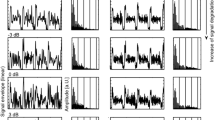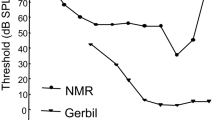Summary
Territorial maleHaplochromis burtoni (Teleostei; Cichlidae) have a dark facial stripe, the ‘eyebar’, which can appear and disappear within seconds, independently of other coloration patterns. It is used to signal territory ownership and aggressive intent. Some males, called ‘barless’, have functional melanophores in the eyebar region but never display this pattern, because melanin in eyebar pigment cells is never dispersed.
The eyebar melanophores are controlled by a specialized branch of the maxillary nerve. Lesioning the ‘eyebar nerve’ resulted in immediate melanin dispersion and consequent darkening of the eyebar pattern, and it abolished the normal paling response in all behavioral situations. Nerve lesion produced similar results in both barred and barless males, except that the coloration of the denervated eyebar in barless males was more similar to camouflage markings than to the conspicuous black eyebar used as a social signal.
Electrical stimulation of the maxillary nerve produced melanin aggregation. Photoelectric recordings of this paling response revealed no differences between barred and barless males, or between the eyebar and other facial chromatophores that do not function as visual displays. Thus, the difference in the physiological state of eyebar melanophores in intact barred and barless males cannot be explained by differences in peripheral nerve anatomy or physiology.
Similar content being viewed by others
References
Baerends GP (1976) The significance of colour patterns in fish for the study of some fundamental tissues in behaviour. Rev Trans Inst Peches Mark 40:413–423
Bagnara JT, Hadley ME (1973) Chromatophores and color change. Prentice Hall, Englewood Cliffs
Bauer DH, Demski LS (1980) Vertical banding evoked by electrical stimulation of the brain in anaesthetized green sunfishLepomis cyanellus and bluegills,Lepomis machrochirus. J Exp Biol 84:149–160
Cott HB (1957) Adaptive coloration in animals. Methuen, London
Denton EJ, Land MF (1971) Mechanism of reflexion in silvery layers of fish and cephalopods. Proc R Soc Lond A 178:43–61
Euler US von (1959) Autonomic neuroeffector transmission. In: Handbook of physiology, sect. 1. Neurophysiology, vol 1. Am Physiol Soc, Washington DC, pp 215–237
Falck B, Muntzing J, Rosengren AM (1969) Adrenergic nerves to the dermal melanophores of the rainbow trout,Salmo gairdneri. Z Zellforsch 99:430–434
Fernald RD (1977) Quantitative observations ofHaplochromis burtoni under semi-natural conditions. Anim Behav 25:643–653
Fernald RD (1980) Response of male cichlid fish,Haplochromis burtoni, reared in isolation to models of conspecifics. Z Tierpsychol 54:85–93
Fernald RD, Hirata NR (1977 a) Field study ofHaplochromis burtoni: Habitats and cohabitants. Env Biol Fish 2:299–308
Fernald RD, Hirata NR (1977b) Field study ofHaplochromis burtoni: Quantitative behavioral observations. Anim Behav 25:964–975
Fine ML, Winn HE, Olla BL (1977) Communication in fishes. In: Sebeok TA (ed) How animals communicate. Indiana University Press, Bloomington, pp 472–518
Frisch K von (1911) Beiträge zur Physiologie der Pigmentzellen in der Fischhaut. Arch Ges Physiol 138:319–387
Fujii R (1969) Chromatophores and pigments. In: Hoar WS, Randall DJ (eds) Fish physiology, vol II. Academic Press, New York, pp 307–353
Fujii R, Novales R (1969) The nervous mechanism controlling pigment aggregation inFundulus melanophores. Comp Biochem Physiol 29:109–124
Gray EG (1956) Control of the melanophores of the minnow (Phoxinus phoxinus L.). J Exp Biol 33:448–459
Hailman JP (1977) Optical signals. Fitzhenry and Whiteside, Don Mills, Ontario, Canada
Healey EG (1951) The colour change of the minnowPhoxinus laevis (AG). I. Effects of spinal section between vertebrae 5 and 12 on the responses of the melanophores. J Exp Biol 28:297–319
Heiligenberg W, Kramer U, Schulz V (1972) The angular orientation of the black eye-bar inHaplochromis burtoni (Cichlidae, Pisces) and its relevance to aggressivity. Z Vergl Physiol 76:168–176
Hoyle G (1957) Comparative physiology of the nervous control of muscular contraction. Cambridge University Press, Cambridge
Land MF (1972) The physics and biology of animal reflectors. Progr Biophys Molec Biol 24:75–106
Leong C-Y (1969) The quantitative effect of releasers on the attack readiness of the fishHaplochromis burtoni (Cichlidae: Pisces). Z Vergl Physiol 65:29–50
Muske LE (1983) To bar or not to bar? Control of a social signal. PhD Diss, University of Oregon
Muske LE, Fernald RD (1987) Control of a teleost social signal. II. Anatomical and physiological specializations of chromatophores. J Comp Physiol A 160:99–107
Odiorne JM (1957) Color changes. In: Brown ME (ed) The physiology of fishes, vol 2. Academic Press, New York, pp 387–401
Oshima N, Fujii R (1984) A precision photoelectric method for recording chromatophore responses in vitro. Zool Sci 1:545–552
Pye JD (1964) Nervous control of chromatophores in teleost fishes. I. Electrical stimulation in the minnowPhoxinus phoxinus (L.). J Exp Biol 41:525–534
Waring H (1963) Color change mechanism of cold-blooded vertebrates. Academic Press, New York
Zar JH (1974) Biostatistical analysis. Prentice-Hall, Englewood Cliffs, N.J.
Author information
Authors and Affiliations
Rights and permissions
About this article
Cite this article
Muske, L.E., Fernald, R.D. Control of a teleost social signal. J. Comp. Physiol. 160, 89–97 (1987). https://doi.org/10.1007/BF00613444
Accepted:
Issue Date:
DOI: https://doi.org/10.1007/BF00613444




